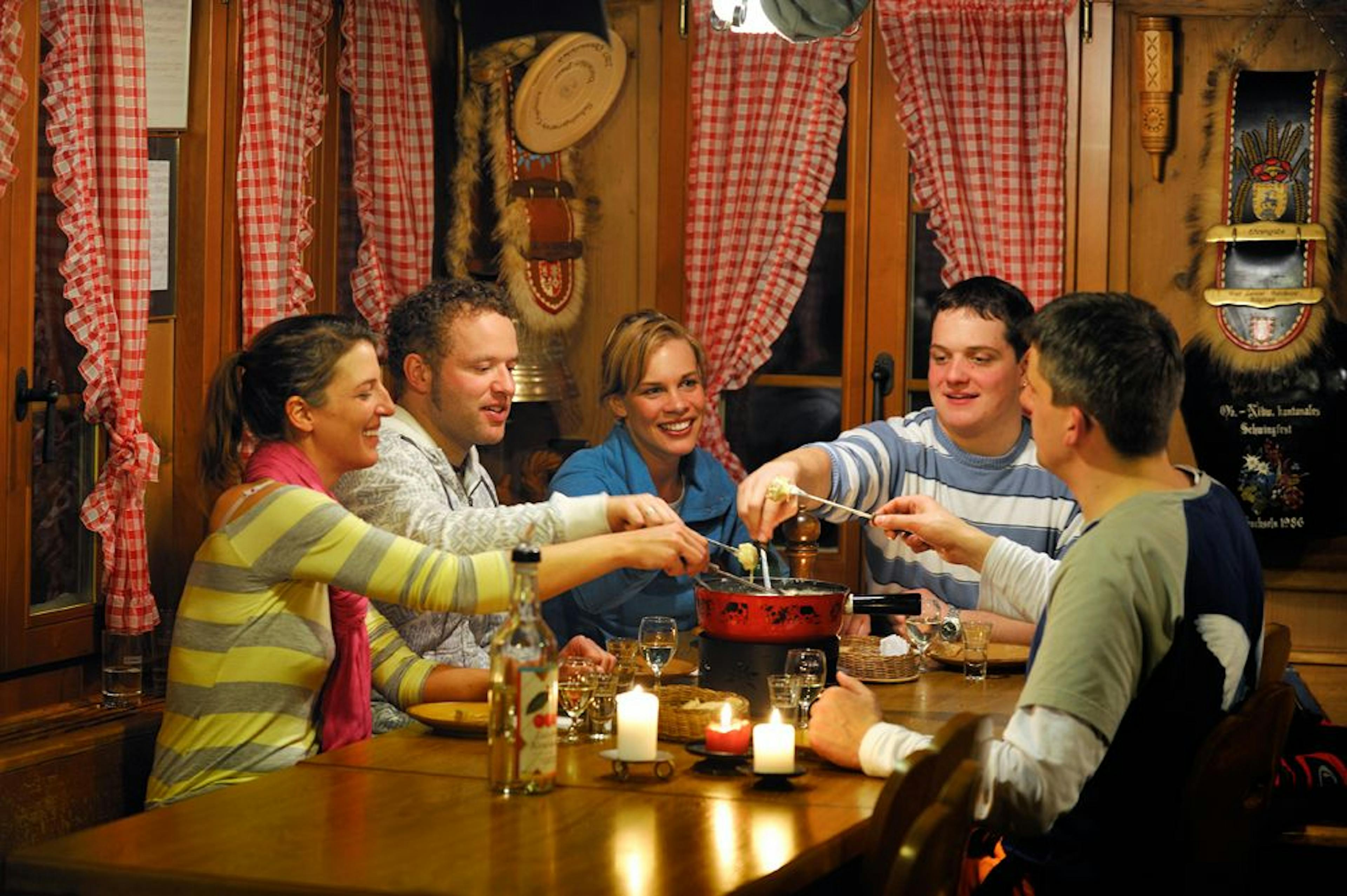
38 typical and delicious Swiss specialties
In this article you will find 38 delicious dishes and desserts that are typical for Switzerland. Switzerland is mostly known for chocolate and cheese. But there are many other specialties that you probably have never heard of.
Cheese and chocolate - that's what the small Switzerland is known for almost all over the world. In fact, these two ingredients are present in many well-known and locally loved dishes. This probably won't surprise you either, as they are often enjoyed with loved ones, family, and friends.
However, the Swiss don't just live on chocolate and cheese. Swiss cuisine is influenced by the surrounding countries, but also by the different landscapes and regional traditions. In Ticino, for instance, you'll find typical Mediterranean influences, while the mountainous Alpine regions offer hearty fare.
A culinary tour of Switzerland is certainly worthwhile and can be perfectly combined with an exploration of our beautiful country. Whether in the big city by the lake or in a small, remote mountain village - Swiss specialties are waiting to be discovered by you everywhere.
Cheese Fondue
What is it?
Cheese fondue is a true classic in Switzerland. A mixture of cheeses is melted, refined with white wine and kirsch as desired, and served bubbling in the center of the table on a “Rechaud”. Traditionally, you dip pieces of bread into the cheese, but potatoes, pears, and apples also work well. Swiss white wine or black tea is typically enjoyed with it, and after the meal, a glass of kirsch is often shared. Check out our article on the 13 unusual places for cheese fondue. Here you'll also find facts and information about the Swiss national dish itself.
Where can I try it?
Fondue is especially eaten all over Switzerland during the colder months. However, true aficionados don't shy away from cozying up with fondue, even at 30 degrees in summer. You’ll certainly enjoy the delicacy best in a snow-covered mountain hut surrounded by your loved ones.
Raclette
What is it?
Raclette is another typical Swiss cheese dish. In recent years, countless refined varieties have joined the classic natural version. There are options like pepper, bacon, garlic, herb, or chili cheese. The cheese is sliced about 5 mm thick and melted in small pans on the table grill, traditionally served with potatoes.
When it comes to side dishes, you have plenty of choices: pickles, pearl onions, pickled vegetables, bacon, small sausages, chili, pepper, pears, and much more. Every Swiss has their personal favorites here - try it out and find out what you like best!
Where can I try it?
Raclette is celebrated in many families during the cooler days as a cozy gathering. You can find selected varieties and a wide range of side dishes at retailers or in specialty stores. Raclette is also often offered at Christmas markets, in mountain regions, and in cozy alpine huts.
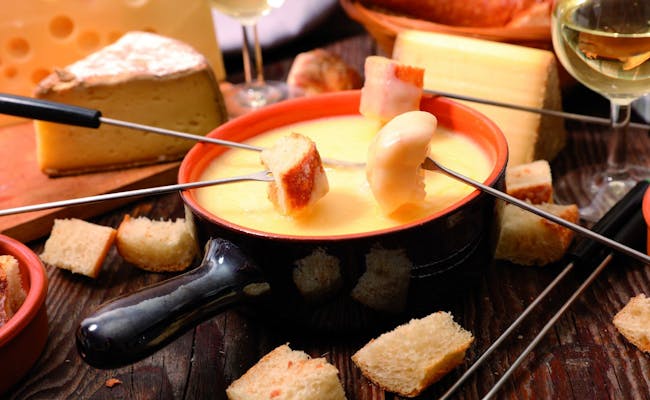 Fondue (Photo: MySwitzerland)
Fondue (Photo: MySwitzerland)
Rösti
What is it?
Rösti can be enjoyed as a standalone main dish or as a side. It’s made by pre-cooking potatoes, grating them, and frying them until crispy and golden brown, forming a delicious “potato pancake.” Depending on the region, Rösti is often garnished with bacon, cheese, tomatoes, onions, or a fried egg before being served.
Where can I try it?
Rösti is commonly featured as a main dish in mountain regions. However, you’ll also find it as part of the classic “Zürcher Geschnetzeltes” in good traditional restaurants.
Capuns
What is it?
Capuns is a typical main dish from the canton of Graubünden. It consists of a “spätzle base” mixed with bacon, salsiz, and raw ham, along with various herbs, all wrapped in a chard leaf. The bundles are cooked in a broth and often topped with mountain cheese. There are countless variations of Capuns – just like Grandma makes it best!
Where can I try it?
The best place to enjoy Capuns is in Graubünden, where you can find this popular dish in various combinations at nearly every mountain and valley restaurant.
 Rösti (Photo: MySwitzerland)
Rösti (Photo: MySwitzerland)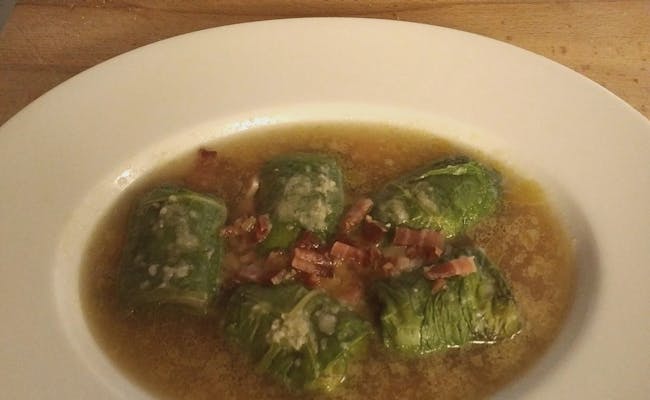 Capuns (Photo: MySwitzerland)
Capuns (Photo: MySwitzerland)Cholera
What is it?
Despite the disturbing name, don't be afraid of this dish. The covered vegetable cake originates from Valais. It usually involves filling puff pastry with potatoes, leeks, cheese and apples and baking it
A possible explanation for the unusual name is actually that the dish originated during a cholera epidemic, when no one was allowed to leave the house. As a result, the population was forced to eat from the products that were usually stocked.
Where can I try it?
The best place to try cholera is in a restaurant on your next trip to Valais.
Malun's
What is it?
Maluns are grated, fried potatoes. At first glance, the "crumbly" main dish looks unusual. However, it tastes great with applesauce and a good piece of mountain cheese. It is said that you actually classically drink a latte with it. However, you may also choose another drink
Where can I try it?
Maluns is a specialty from the canton of Grisons. Wherever a restaurant offers Graubünden classics, you can order the dish.
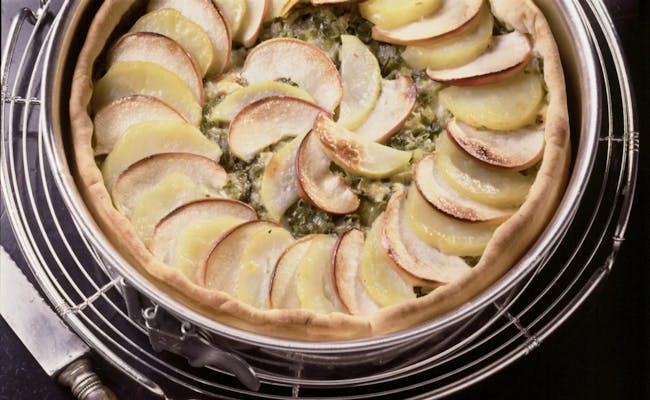 Cholera (Photo: MySwitzerland)
Cholera (Photo: MySwitzerland) Maluns (Photo: MySwitzerland)
Maluns (Photo: MySwitzerland)Zürcher Geschnetzeltes
What is it?
A dish that Mr. and Mrs. Swiss love to enjoy in restaurants. Zürcher Geschnetzeltes is made from veal in a creamy mushroom sauce. Don’t confuse it with Geschnetzeltes Zürcher Art; in that dish, veal is usually substituted with pork.
It is typically served with rösti and traditionally also with “Nierli” (veal kidneys), though these are now rarely offered and usually optional for the guest.
Where can I try it?
You can find Zürcher Geschnetzeltes in many traditional restaurants across Switzerland. But why not try it in a historic venue in Zürich that matches its name?
St. Galler Bratwurst
What is it?
The famous white bratwurst is protected by an IGP. IGP stands for Indication Géographique Protégée - this means it’s a very traditional product that is safeguarded by certain regulations.
For St. Galler Bratwurst, this means that there are rules regarding where the sausage can be produced, what spices can be used, and what types of meat may be included in what percentage. There are four varieties of St. Galler Bratwurst, with the most famous likely being the OLMA bratwurst, named after the well-known folk festival.
Where can I try it?
Why not combine your bratwurst tasting with a visit to OLMA? This event takes place every October in St. Gallen and serves as both a fair and a folk festival. But be careful: a St. Galler Bratwurst is definitely eaten without mustard. Grabbing the tube can earn you some disapproving looks, especially in the region of origin, where it is particularly frowned upon.
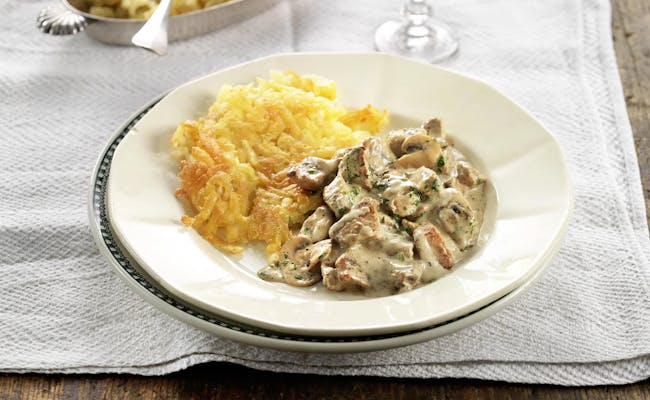 Zürich-style sliced veal (Photo: MySwitzerland)
Zürich-style sliced veal (Photo: MySwitzerland)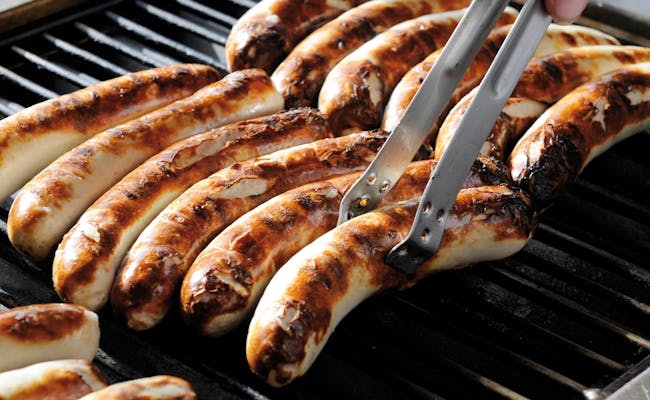 St. Gallen Sausage (Photo: MySwitzerland)
St. Gallen Sausage (Photo: MySwitzerland)Älplermagronen
What is it?
Älplermagronen are a popular dish, especially among children, often enjoyed during ski vacations. Topped with a creamy cream sauce and cheese, the macaroni and potato pieces are garnished with bacon and onions, making them another one of Switzerland's hearty main dishes. If you are a fan of salty-sweet combinations, you will surely like the dish. It is served with a portion of apple sauce.
Where can I try it?
Älplermagronen are offered mainly in the mountain regions. For the Swiss, it is a classic menu during hiking or skiing vacations.
Birchermüesli
What is it?
What was originally a common dinner for the common people is now an internationally popular classic on the breakfast buffet: the Birchermüesli. The basis is cereal flakes, nuts, fruit and milk. The dish was made famous by Doctor Maximilian Oskar Bircher-Benner, who prescribed the muesli to his patients as an easily digestible evening meal. This then gave rise to the Birchermüesli.
Where can I try it?
You can prepare a Birchermüesli wonderfully by yourself. So you can add components such as yogurt or honey and flavor the muesli to your liking. Since the Birchermüesli is very filling, it is suitable as breakfast but also as a snack for your next day trip.
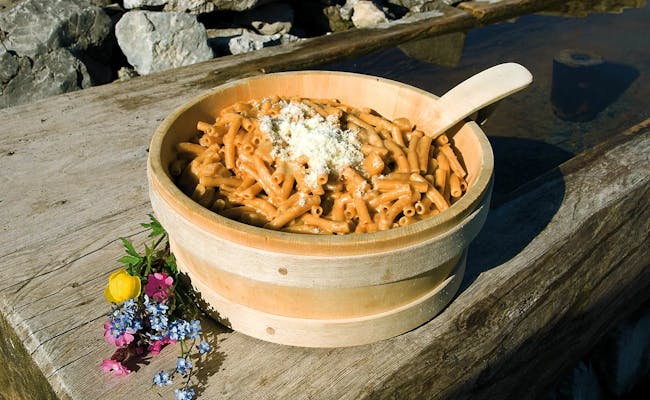 Älpler Macaroni (Photo: MySwitzerland)
Älpler Macaroni (Photo: MySwitzerland) Bircher Müesli (Photo: MySwitzerland)
Bircher Müesli (Photo: MySwitzerland)Grisons barley soup
What is it?
Another well-known and hearty dish from the canton of Grisons is the Bündner Barley Soup. It contains rolled barley, vegetables, bacon and/or Bündnerfleisch as well as fresh herbs. Due to the various ingredients, the soup is very nutritious and is therefore often eaten in the colder months.
Where can I try it?
You can also often find this Grisons classic to choose from in traditional restaurants that offer a Grisons menu. Moreover, it warms and strengthens you perfectly during a cold skiing day.
Hörnli and Ghackets
What is it?
The favorite dish of so many Swiss children - and young-at-heart adults - is Hörnli mit Ghackets. Translated from Swiss German, this means pasta with minced meat sauce. Quite simple in itself. But the perfection comes only when a good portion of grated cheese and applesauce are added. The best thing is to mix everything once and enjoy.
Where can I try it?
Hörnli and Ghackets is a typical family dish. You don't need to be a star chef to serve it at the next cozy evening with family and friends. Add a glass of wine and the menu is perfect.
Berner plate
What is it?
The Bernerplatte is a very traditional dish, which due to the "from-nose-to-tail movement" - in a modified form - is gaining in topicality. It can be compared to a butcher's platter. A wide variety of meats and offal such as bacon, ribs and tongue are prepared and served with potatoes, beans and sauerkraut.
Where can I try it?
Because of the many different components, you best enjoy the Bernerplatte together with some friends or family. Place the individual pieces and dishes in the center of the table, pass bowls around and taste.
 Barley Soup (Photo: MySwitzerland)
Barley Soup (Photo: MySwitzerland)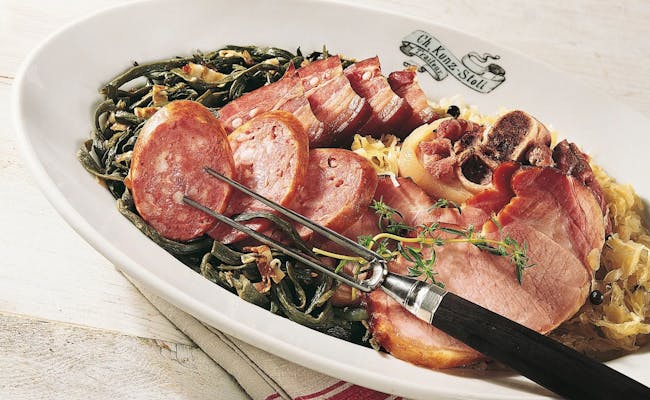 Berner platter (Photo: MySwitzerland)
Berner platter (Photo: MySwitzerland)Pastetli with Brätchügeli
What is it?
A classic from childhood days: puff pastry pies filled with Brätchügeli (small balls of sausage meat) on a creamy cream sauce and often supplemented with mushrooms or morels. This dish has made many a child's eyes light up when it came home from school smelling the tempting lunch
Where can I try it?
Pastetli with Brätchügeli is a favorite dish in Swiss households. In a somewhat simpler form for lunch or in a more elegant form as a Sunday menu. And that's exactly how you'll find it in the various restaurants: from the lunch recommendation to a fixed part of the evening menu.
Stunggis
What is it?
Stunggis is a Swiss term and stands for a stew from the central Swiss canton of Nidwalden. Pork stew is stewed together with vegetables and potatoes and then enjoyed in the same way. Attention: with "Gummelestunggis" there is a very similar sounding term in Switzerland. However, this one stands for potatoes (Gummele) and stunggis (mash). So a kind of mashed potatoes
Where can I try it?
Stunngis is a central Swiss menu. As with most other dishes, the best place to try it is in its region of origin. Or you can choose one of the numerous recipes and just try it yourself.
Polenta
What is it?
Polenta is probably best translated as "corn porridge". It can be served as a side dish, but it can also be a main dish on its own. So polenta is very changeable. Depending on what you prefer, you can use very fine to coarse-grained cornmeal
The polenta can then be served creamy as a side dish with a starter, with Gorgonzola and dried tomatoes as a main course, or in a modified form as a polenta slice. Just try it out and see how you like the corn dish best - there are almost no limits to your creativity.
Where can I try it?
Polenta has its origin in Italy. That's why in Switzerland you can find it most common in the southern canton of Ticino. Indulge yourself in a "grotto" or give free rein to your creativity and create your own polenta!
 Pastetli (Photo: MySwitzerland)
Pastetli (Photo: MySwitzerland)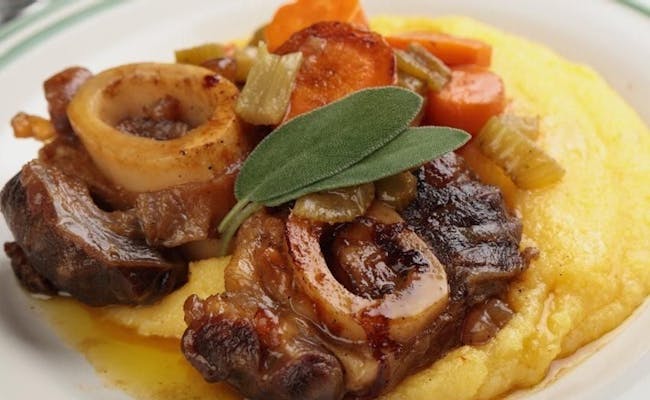 Polenta (Photo: MySwitzerland)
Polenta (Photo: MySwitzerland)Saucisson
What is it?
The saucisson is a large, coarse-grained sausage that can be enjoyed only when cooked. The sausage speciality is known mainly in the French-speaking part of Switzerland. The different regions have their own recipes. Some of them are even protected by law with a designation of origin. The sausage - or part of it - is usually served in combination with a hearty dish. Always suitable are potatoes, leeks and beans.
Where can I try it?
Saucisson is often offered as a component of a "Metzgete-Platte" (slaughter plate). In its region of origin, however, you can also find the specialty in gastronomy or in retail stores for personal tasting at home.
Basel flour soup
What is it?
The Basler Mehlsuppe is considered a traditional dish in Basel and is especially during the "most beautiful days of the year" - the Basler Fasnacht - cult and duty at the same time. The soup consists of bouillon, wine and roasted flour. For shine and taste it is refined with onions and bacon or pig's feet.
Where can I try it?
Since the Basel Carnival is a Swiss experience of a special kind, why not combine your visit with a taste of the flour soup? But beware - getting up early is a must here...
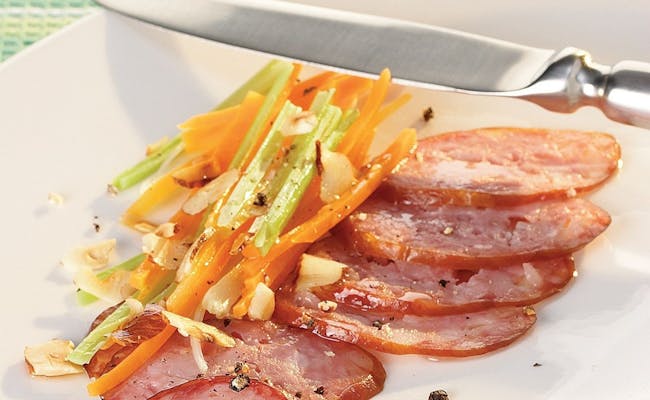 Sausage (Photo: MySwitzerland)
Sausage (Photo: MySwitzerland)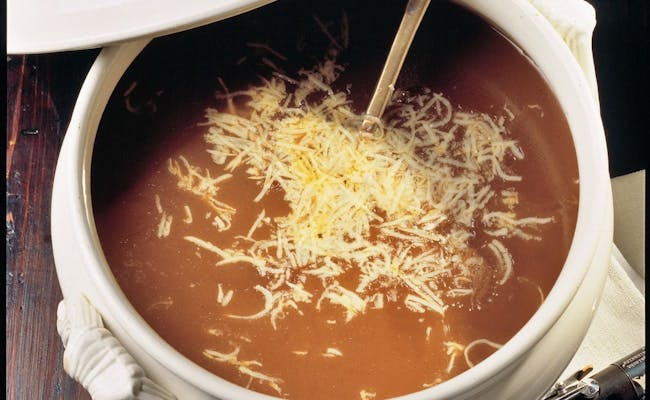 Basel flour soup (Photo: MySwitzerland)
Basel flour soup (Photo: MySwitzerland)Heissi Marroni
What is it?
When the days become shorter and the fog creeps through the valleys, this scent also travels through the train stations and the streets of the city. Chestnuts are roasted and sold to passers-by as a snack. The sweet chestnut grows in Switzerland in the canton of Ticino. The actual fruit can be found in autumn carpeting the forest floor in the southern canton. But be careful, it is well packed in a prickly and prickly shell.
Where can I try it?
Hot marroni can be found in autumn and winter at train stations and in the city centers at small market stalls. You can also try the chestnuts at Christmas markets. The nice side effect: The bag with the hot chestnuts warms your hands at the same time. So nothing stands in the way of a cozy Christmas stroll!
Magenbrot
What is it?
Magenbrot is a popular dessert that can be bought at fairs and Christmas markets. However, Magenbrot does not resemble a classic loaf of bread as you know it. The small pieces, which are usually sold in pink bags, are dark brown and consist of flour, milk-water, Christmas spices, chocolate and honey
Where can I try it?
At any Swiss market big or small - just follow the sweet smell and you will find it.
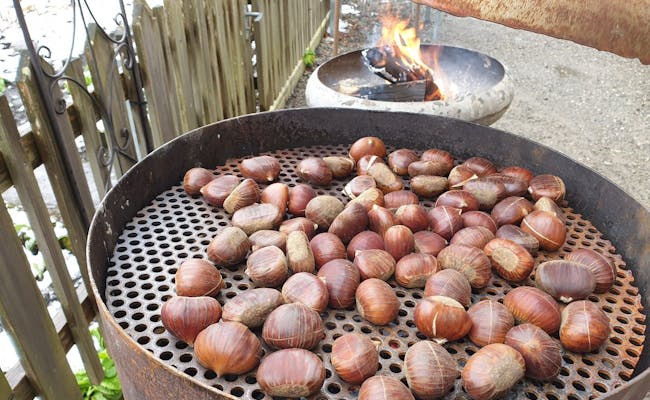 Heissi Marroni (Photo: MySwitzerland)
Heissi Marroni (Photo: MySwitzerland)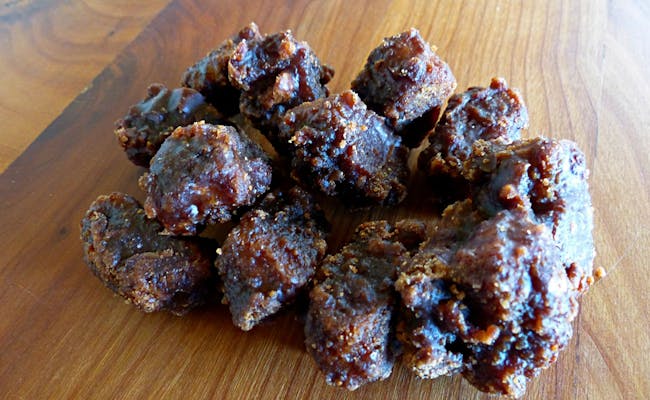 Magenbrot (Photo: Seraina Zellweger)
Magenbrot (Photo: Seraina Zellweger)Roasted Almonds
What is it?
Roasted almonds are just as much a part of the “Chilbi” and Swiss markets as Magenbrot. The almonds are cooked with sugar, cinnamon, and water. As the water evaporates, a sweet, crunchy coating forms around the almonds.
Where can I try it?
The best place to enjoy this tasty treat is at a Christmas market, paired with a visit to a Swiss city. You definitely don’t want to miss the special Christmas market in Montreux by Lake Geneva; it’s a trip worth taking.
Chocolate
What is it?
Switzerland is famous worldwide for its chocolate. Whether it’s Easter bunnies, gummy bears, Lindor truffles, Branchli sticks, or Toblerone, you'll find a suitable chocolate variety for any occasion and season, whether for a big celebration or a little treat. Some of the major manufacturers in Switzerland include Lindt, Sprüngli, Läderach, and Cailler.
Where can I try it?
Of course, you’ll find a wide selection in retail stores to taste various types. To make the tasting experience truly special, consider combining it with a visit to a chocolate factory.
In our guide to chocolate factories in Switzerland, you’ll find everything you need to know for your visit.
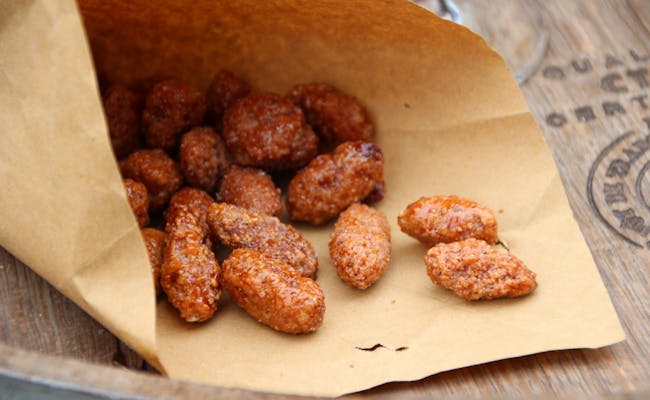 Roasted almonds (Photo: Seraina Zellweger)
Roasted almonds (Photo: Seraina Zellweger) Läderach chocolate (Photo: Seraina Zellweger)
Läderach chocolate (Photo: Seraina Zellweger)Weggli and Brügeli
What is it?
Weggli and Brügeli translates to "milk rolls and chocolate bars." This combination is a popular snack throughout Switzerland. In the classic version, you get a round, ridged Weggli with a chocolate bar. Some bakeries use the saying "You can't have your cake and eat it too" and swap the chocolate stick for a large chocolate coin. Sometimes, you can indeed have both.
Where can I try it?
You can buy Weggli and Brügeli in almost every bakery or retail store in various sizes and styles.
Gottlieber Hüppen
What is it?
The delicate, rolled crepes with different fillings gained fame through a company in Gottlieben, in the Canton of Thurgau. The charming little town by Lake Constance is definitely worth a visit. At "Gottlieber," you can taste the various Hüppen and discover your favorite filling. The classic varieties include praline, mocha, and gianduja.
Where can I try it?
You can buy Hüppen in several pastry shops and retailers across Switzerland. The Gottlieber company has its own cafes in some cities outside the Canton of Thurgau, like Aarau, Basel, Winterthur, or Zug. Still, we recommend you try the Hüppen where they originated: in Gottlieben itself.
 Brügeli and Weggli (Photo: Seraina Zellweger)
Brügeli and Weggli (Photo: Seraina Zellweger)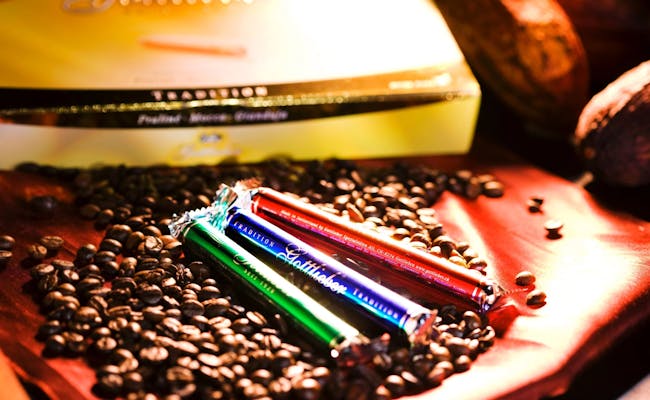 Gottlieber Hüppen (Photo: MySwitzerland)
Gottlieber Hüppen (Photo: MySwitzerland)Luxemburgerli
What is it?
The small, colorful macarons immediately catch your eye as you walk into a Sprüngli store. This Swiss delicacy, which has reached cult status, is now available in a variety of fillings: from chocolate to vanilla, mocha, and champagne to passion fruit, raspberry, and pistachio. There’s definitely something for everyone’s taste.
Where can I try it?
You can find Luxemburgerli at any Sprüngli store, particularly in the city of Zurich and at Swiss train stations. They’re also available internationally at airports worldwide. By the way, Luxemburgerli are a popular gift or culinary souvenir from Switzerland.
Zuger Kirschtorte
What is it?
As the name suggests, this is an alcoholic cake from the canton of Zug. Since 2015, the name has been legally protected and can only be produced in the originating canton and must contain “AOP Zuger Kirsch.” AOP stands for “Appellation d’Origine Protégée,” a protected designation of origin with strict production guidelines. In this dessert, the light sponge cake is soaked in kirsch, and the cake is additionally filled with a kirsch cream.
Where can I try it?
The best place to try Zuger Kirschtorte is, of course, in the canton of Zug. Zug itself is a lovely city right by the lake. You can stroll through the streets, dip your feet in the cool water, and sweeten your afternoon with a piece of cherry cake. What more could you want?
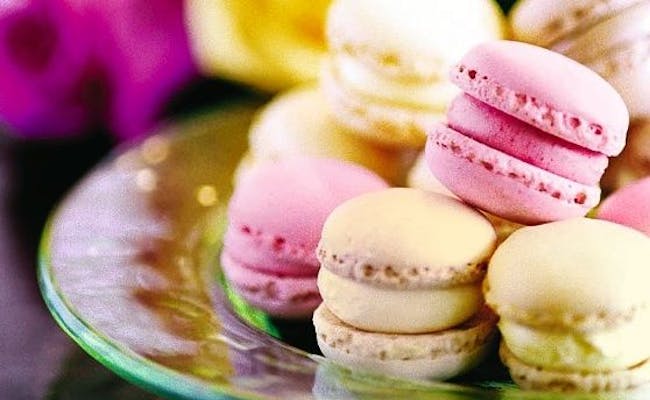 Luxemburgerli (Photo: MySwitzerland)
Luxemburgerli (Photo: MySwitzerland) Zug cherry cake (Photo: MySwitzerland)
Zug cherry cake (Photo: MySwitzerland)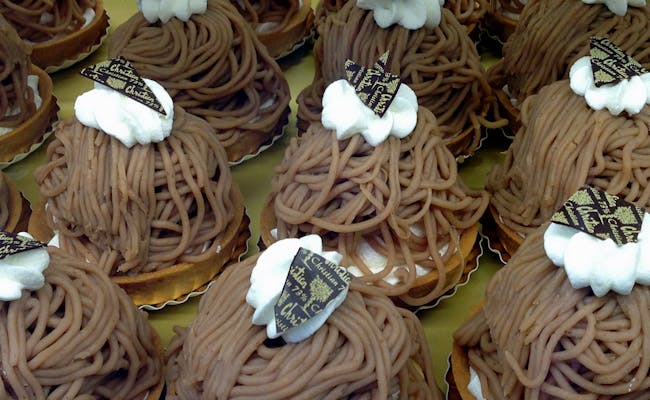 Vermicelles (Photo: Seraina Zellweger)
Vermicelles (Photo: Seraina Zellweger)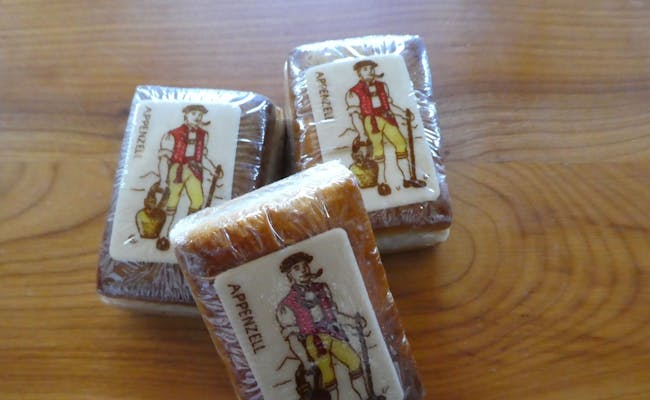 Appenzeller Biberli (Photo: Seraina Zellweger)
Appenzeller Biberli (Photo: Seraina Zellweger)Nidelzeltli
What is it?
Nidelzeltli are available in different variations in different Swiss cantons. While in the canton of Appenzell the typical square candies are hard as a rock, the crumbly, creamy varieties from Basel or Bern disintegrate directly in the mouth. In any case, however, the strong caramel flavor, which comes from the main ingredients sugar and cream, is typical.
Where can I try it?
Nidelzeltli are part of the classic equipment of a candy fair stand. You can find them there all year round. But also in the supermarket you can find Nidelzeltli in different variations.
Bündner Nusstorte
What is it?
The round, rather flat cake, comes along very inconspicuous. The shortcrust pastry encloses the caramelized, coarsely chopped tree nut mass. Although the filling tends to stick in your teeth, it is worth tasting the sweet dessert. But be warned: the Bündner Nusstorte is a real calorie bomb and keeps you full for a very long time.
Where can I try it?
In the canton of Graubünden you can find the famous nut tart in various bakeries but also as a fixed component on the dessert menu in restaurants and cafés. It is also available in packaged versions in supermarkets. So you can take a Bündner Nusstorte with you on your next hike
Basler Läckerli
What is it?
The classic Basler Läckerli is small, square and decorated with a light sugar icing. In the meantime, however, there are numerous variations of the rather hard gingerbread pastry: for example, coated with chocolate or refined with fruit flavors. It is not known how many teeth the Läckerli has already claimed as victims. So be careful if you have problems with your teeth. The cookies are sometimes very hard or difficult to chew
Where can I try it?
The best place to visit is the Genusswelt in the Läckerli Huus in Frenkendorf in the canton of Basel Land. There you can learn more about the production and the history and taste the different varieties on the spot. Otherwise, you will find various branches of the Läckerli Huus all over Switzerland
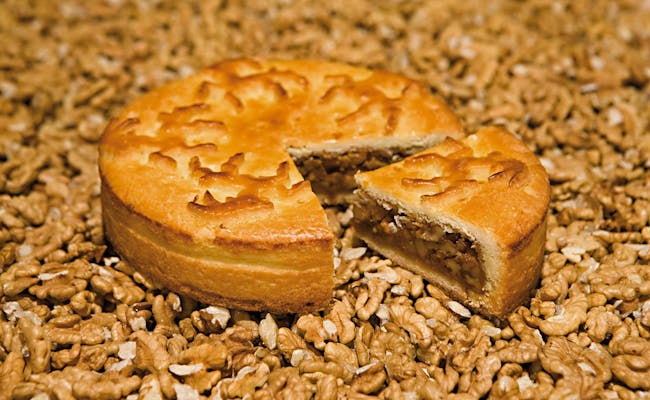 Grisons Nut Cake (Photo: MySwitzerland)
Grisons Nut Cake (Photo: MySwitzerland) Basler gingerbread (Photo: Seraina Zellweger)
Basler gingerbread (Photo: Seraina Zellweger)Meringue
What is it?
A meringue on a plate looks almost like a small cloud. Despite its airy appearance, it is actually quite hard and crumbly. To make it, egg whites are whipped with sugar and dried out in the oven until lightly caramelized. Alongside the classic version, there are more and more interpretations with various flavors, such as chocolate or pistachios.
Where can I try it?
Meringue is often served in the Bernese Emmental, Haslital, and Western Switzerland. You'll typically find it on dessert menus as a complement to a scoop of ice cream or as the main component garnished with whipped cream.
Pear Weggen
What is it?
The Pear Weggen, originating from Lucerne, is made from yeast, shortcrust, or less commonly, puff pastry, filled with a spiced pear puree. In the classic, larger version, the dough is rolled up with the filling. The smaller “Bireweggli” is simply filled. You can enjoy this dish as a light snack or as dessert.
Where can I try it?
Because of its origin, you'll find Pear Weggen in bakeries in Lucerne. However, it's also well-known in the rest of German-speaking Switzerland and can be found in supermarkets.
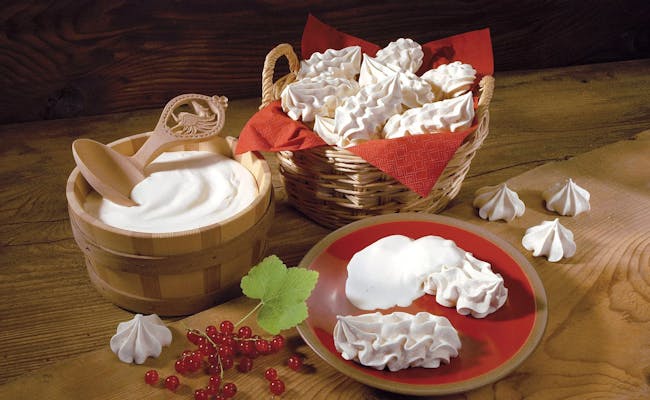 Meringue (Photo: MySwitzerland)
Meringue (Photo: MySwitzerland) Pear pastries (Photo: Seraina Zellweger)
Pear pastries (Photo: Seraina Zellweger)Speckmocken
What is it?
Surprisingly, Speckmocken isn't a savory, hearty meat dish but rather a type of pastry. This treat originates from the Appenzell region and consists of puff pastry filled with a hazelnut-condensed milk mixture. When the pastry is rolled and cut, it takes on that characteristic fan-shaped, layered form when baked.
Where can I try it?
The Appenzell region is perfect for hiking and exploring. Treat yourself to a Speckmocken with your coffee during your trip.
Totenbeinli
What is it?
This hard nut pastry originally comes from the Graubünden region. Historically, it was often served at funerals, which is probably how it got its name. Today, Totenbeinli or Nusstängeli is a popular pastry enjoyed throughout Switzerland with coffee.
Where can I try it?
You can easily bake Totenbeinli yourself. The great thing about it is its long shelf-life, so you'll be well prepared for Christmas or a planned outing.
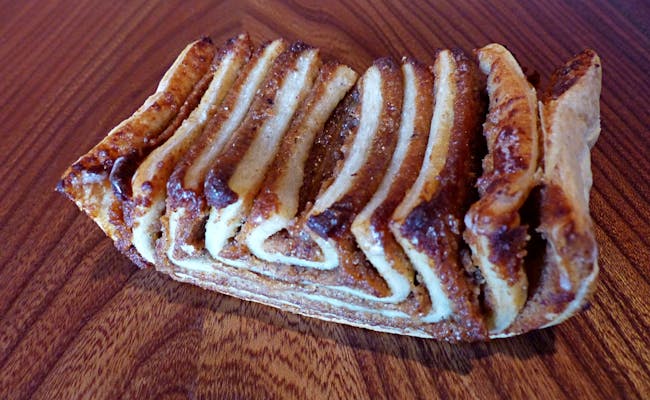 Speckmocken (Photo: Seraina Zellweger)
Speckmocken (Photo: Seraina Zellweger)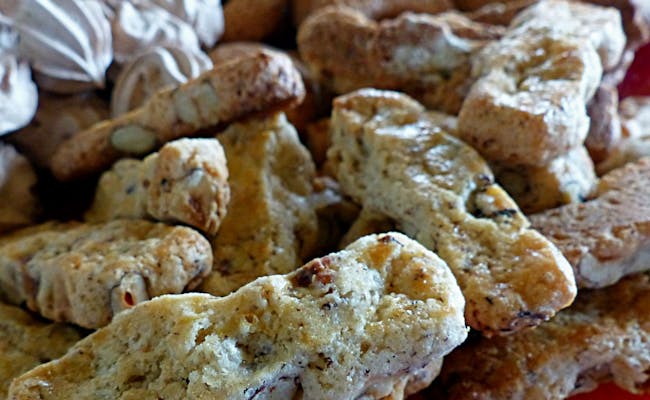 Totenbeinli (Photo: Seraina Zellweger)
Totenbeinli (Photo: Seraina Zellweger)Willisauer Ringli
What is it?
The exact recipe for this ring-shaped pastry is a secret. It’s also been declared that Ringli can only be made in Willisau. This very hard cookie contains sugar, water, flour, lemons, oranges, and honey. Be careful when biting into it—your teeth will thank you!
Where can I try it?
The HUG company is allowed to produce the Willisauer Ringli. In the Ringli shop in Willisau, you can taste these delicacies and watch how they are made right on site. Otherwise, you can find the Willisauer Ringli in most supermarkets.
Badener Steine
What is it?
This confectionery product consists of sponge cake, kirsch, and chocolate. As the name suggests, the Steine come from the town of Baden in the Aargau canton. According to the legend, they originate from the ruins of "Stein" above the town. For those who prefer to skip the strong kirsch flavor, the Moser bakery in Baden has also launched an alternative with Baileys.
Where can I try it?
The Moser bakery in Baden sells the Steine. Try them right there with your coffee. Or if you can't decide between dark or light chocolate, they are also available in larger takeaway packs.
Enjoy your culinary journey across Switzerland and find your favorite specialty.
Discover leisure activities
Book NowTop Destinations
Top Activities
